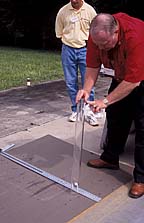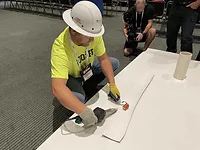Polyisocyanurate Roof Insulation Put to the Test

The stated purpose of the two-day session was to "provide the industry with valuable information and develop new training tools and information for contractors, consultants and property owners." To allow for a broad range of testing, GAF employed the facilities and expertise of PRI Asphalt Technologies in Tampa, Fla. In addition, GAF brought along its video crew to record the event.
The key players in this story include GAF team members Dave Harrison, Helene Hardy Pierce, Tim Larson, Jon Gardner and Lynn Picone. PRI Asphalt Technologies was represented by its vice president, Donald C. Portfolio. The roof consultants who attended and did most of the testing work were William Carrison, Curt Liscum, Brian Gardiner, Joe Hale, Nelson Hall, Lewis Newlan, Robert Martin, James Sheehan, Don Bush Sr. and Luther Mock.
There is a continuing dialog in the industry regarding polyisocyanurate roof insulation and its performing characteristics, particularly since the reformulation of the blowing agents. Certain segments of the industry have been critical of one facer or another, and questions have come up about testing methods and results. Just the same, polyiso continues to hold the commanding lead as the roof insulation of choice. Holding a forum to put several types of polyisocyanurate roof insulation to some real-world, hands-on testing seems an honorable - if risky - way to deal with some of these issues.
What Are We Talking About?
The council began with a meeting in the PRI conference room with a discussion led by Dave Harrison. The basic questions posed to the group were, "What does roof insulation do, and how does iso add value?" The group responded with a list of answers that is so impressive that it bears repeating:
- A level substrate for the roof system
- Hail resistance
- Moisture resistance during construction, during storage and after installation
- Adds dimensional stability to the building
- Adds walking (compression) surface
- Thermal resistance
- Compatibility with other decks and other building materials
- Better R-value per inch (cost competitive - better return on investment than competing insulations)
- Wind resistance
- Securing the roofing system
- Fire resistance
- Workable (contractor friendly)
- Square
That seems a lot to ask from one single building component. The group also answered the question, "What goes wrong (with iso)?" Their answers:
- Cupping, resulting in ponding water and premature delamination
- Facer delamination, resulting in loss of system integrity and R-value
- Custom-fitting boards properly can be a challenge
So what would make the "perfect" polyisocyanurate roof insulation?
- Dimensionally stable, flat, square - regardless of thickness
- Fire resistant
- Hail resistant
- Moisture resistant (before, during and after installation)
- Good attachment
- Stable thermal resistance
- Compressive strength
- Recyclable
- "Taper-able"
- Compatible
- Consistent
- Does not delaminate
Moving on to questions about how these things might matter to a property owner, the group listed several things as "costs of failure," including lower than advertised R-values, blow-offs and poor membrane performance. The discussion turned to the things that can affect stability. The key issues that affect stability cited included heat, thickness of the iso, facer shrinkage, foam quality, moisture and improper curing time.
OK, Let's See
Taking the first part of the discussion, the issues were broken down into four basic groups for the purpose of testing and evaluation:Dimensional stability
Compressive strength
Facer delamination
Compatibility
The council agreed that these would be the issues for testing and evaluation. Working with PRI, a total of 21 different tests were listed as the basis for evaluating these key characteristics of polyisocyanurate with three different facers:
Chopped fiber/organic (short)
Long fiber/organic (long)
Non-organic glass fiber product (non-organic)
Council members were broken down into groups for the purpose of running a battery of tests. All were instructed to record their findings for presentation to the full group at the conclusion of the session. For the purpose of the final presentation, the consultants were asked to state what the test demonstrated, what the (test) scenarios simulate, the results (data observed), and answer the key question, "Why should the property owner care?" Finally, the groups were asked to give their recommendations both in general and in specific situations.
Participants conducted the testing using a variety of methods that included both standard and recognized tests along with some real-world tests. For instance, iso boards with the three different facers were left outside and weighed down with a single concrete paver for three days and nights as one measure of dimensional stability. Pallets of material were also left outside under tarps for a few weeks to simulate job-site conditions. The more "official" tests that took place were conducted with precision instruments and were conducted in accordance with generally accepted testing procedures.
For compressive strength, the iso and facers were subjected to a 13/4-inch ball-drop test, Instron impact test, Mullen burst test and tear-strength test. To determine the difference between the facers for delamination, a "rolling emulator" was used, along with 6-inch by 6-inch and 2-foot by 2-foot wind tests. A water column test of the various facers was attempted, but did not yield usable results. The compatibility tests consisted of an adhesive challenge to determine how user-friendly the various faced isos worked with water-based, solvent-based and asphaltic adhesives.
Tests that the group would like to have completed but could not because of the constraints of time include tests for mold, fastener effects (plastic vs. metal plates), aged peel tests, and tests comparing iso products manufactured to a variety of densities. GAF and PRI had an impressive list of tests prepared in advance of what the council might request but could not have anticipated every single one.
What Was Learned?
At the conclusion of several days of hot, hard work, the roof consultants who made up the GAF National Advisory Council reconvened to reveal their results to the whole group. Some highlights of the presentations:
- The several tests of iso for stability showed clearly that the short and long-fiber organic facers cupped and the iso with non-organic facer laid flat.
- Poor storage can lead to shrinkage of the board.
- Boards that are "cupped" should not be flipped and used, but should be removed from the site
- The 1 3/4-inch ball-drop test revealed that the organic facers experienced considerably more damage than the non-organic-faced material. These results were further born out in the Instron test and the Mullen burst test.
- With the 2-foot by 2-foot wind test, all facers met the minimum standards. In the 6-inch by 6-inch tests, the organic-faced isos had the most deviation between tests, but all met the minimum standards.
- The "rolling emulator" test is relatively new in the field of testing and there is not a standardized test for its use. It does, however, seek to demonstrate the effects of traffic across the top of the insulation or roofing system. These tests did not reveal much in the way of differences between organic and non-organic facers.
- For compatibility, the non-organic facer was somewhat more frugal with adhesives (requiring less material) and easier to work, and the organic facers absorbed adhesives at a faster rate.
- Peel tests were conducted, not in accordance with ASTM or other standards, but did show a real difference between organic and non-organic facers with the highest results going to the non-organic facers.
So What Do You Think?
It could be said that the testing completed at this council was not "perfect" by the strictest of laboratory standards. They were, however, conducted in the confines of a rated and certified testing lab by a group of professional roof consultants who know their materials. The participating roof consultants asked all the right questions, and plenty of them. On balance, they gave this advisory council high marks. Commenting on the time that it takes from a consultant's practice to travel to such a council, roof consultant Jim Sheehan said, "It's not about missing billable hours ... but about the education you get so you can charge (for roof consulting services)." Several of the consultants commented on the fact that GAF's Harrison and Hardy Pierce spend so much time in the field. This kind of experience simply cannot be gained behind a desk.Will results like this convince roof consultants and roofing contractors to offer the slightly more expensive non-organic facers? Time will tell. GAF Materials Corp. will use the video recordings of this advisory council as part of its ongoing efforts to raise the level of training in the industry.
Looking for a reprint of this article?
From high-res PDFs to custom plaques, order your copy today!





